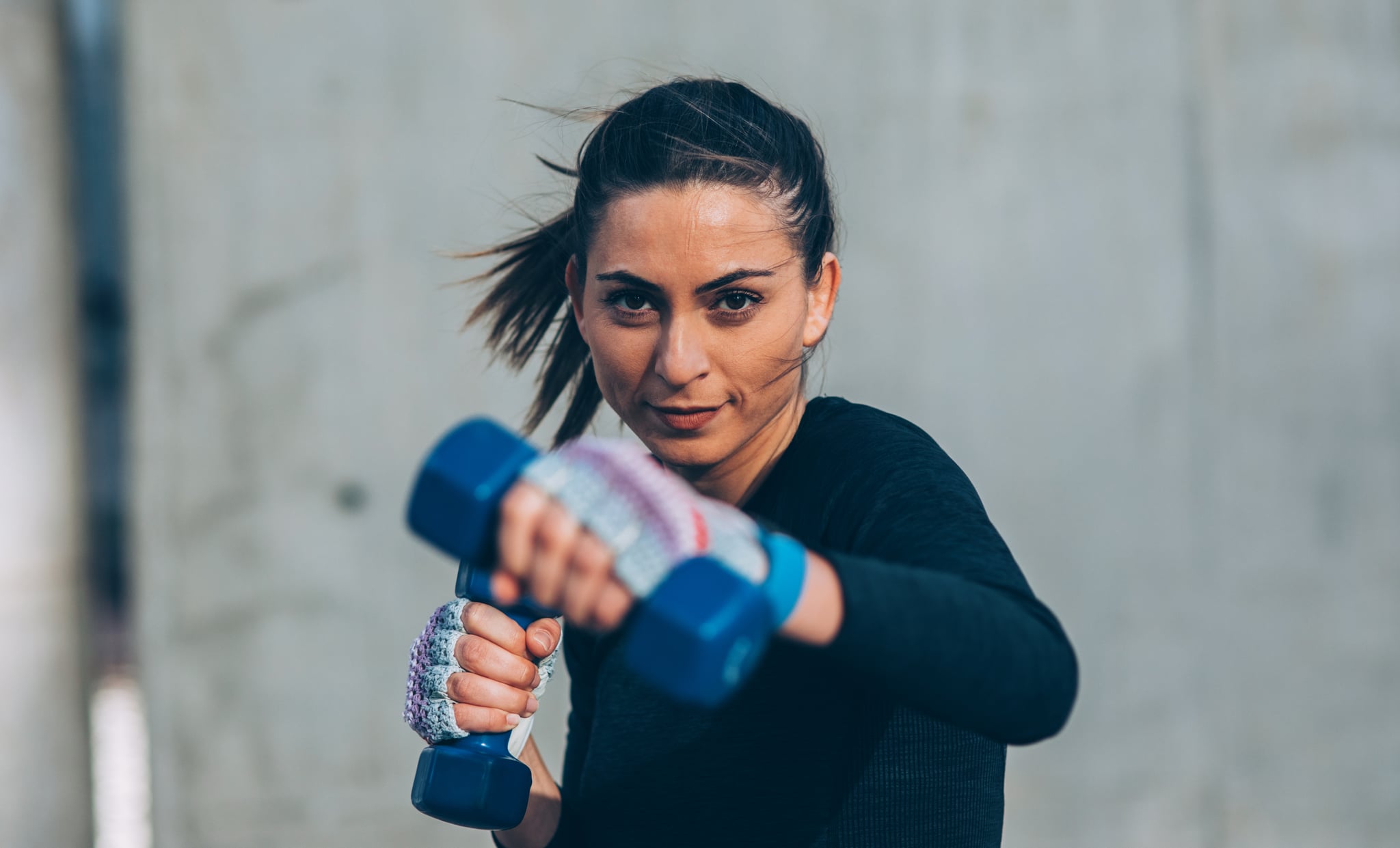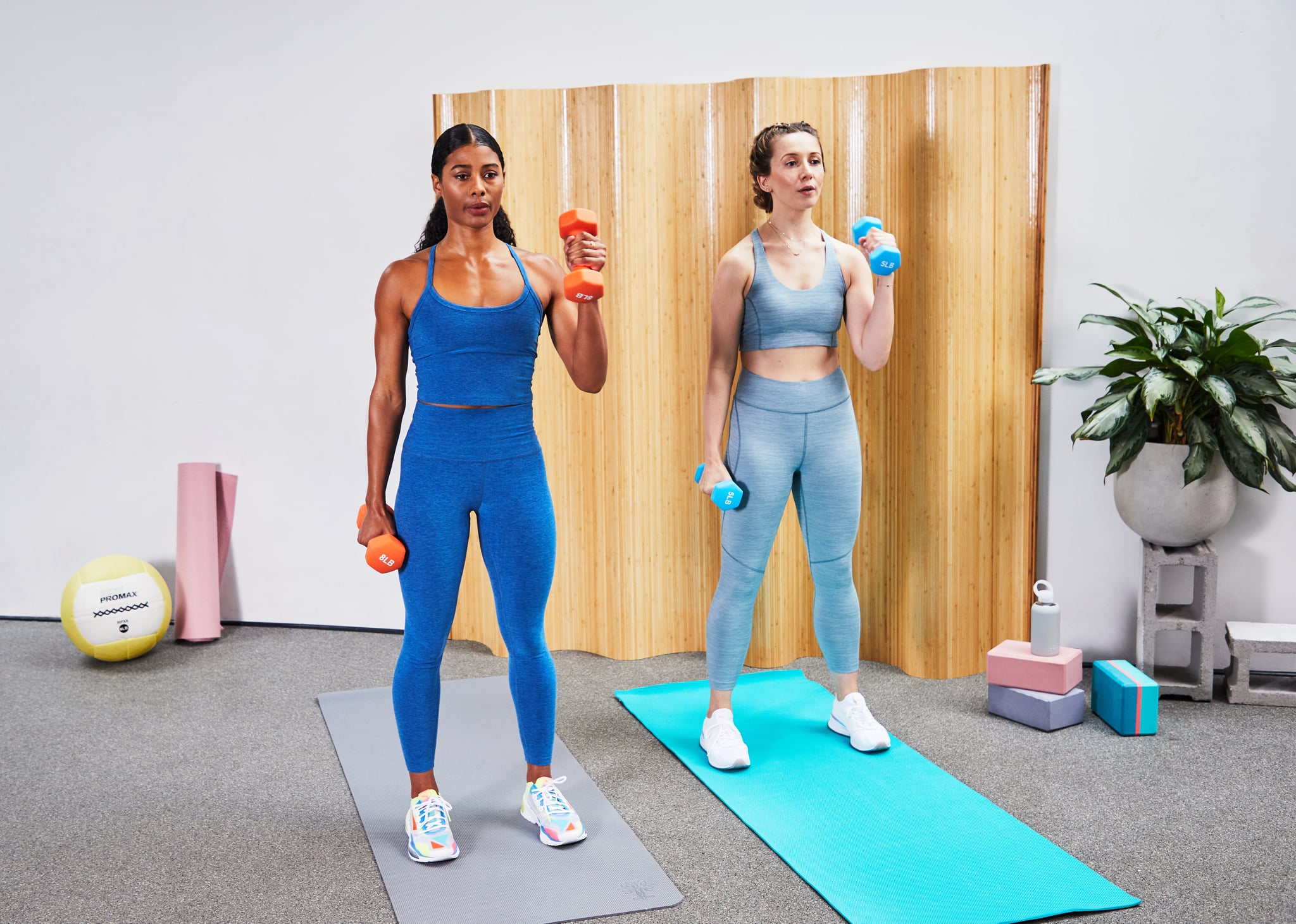
Image Source: Getty / filadendron
Now that you’ve decided to try out strength training, you probably know that the basic idea is utilizing resistance — whether that’s with resistance bands, weights, or simply your own bodyweight — in exercises that tear down your muscles so they can rebuild themselves stronger than before. Weightlifting in particular might feel intimidating if you’re a beginner, but we’re here to tell you it’s much more accessible than you probably thought.
Since you’re thinking it, we’ll say it: there’s a good chance that strength training — breaking down your muscles to build them back stronger — is probably the origin of the quote, “Whatever doesn’t kill you only makes you stronger.” But the good news is, it’s not going to kill you, because we’re here to help you do it right, achieve your goals, and avoid injuries. As effective as weightlifting is for strengthening your muscles, losing weight, and ramping up your metabolism, it’s important to know what you’re doing before you dive in. Straight from the experts, here’s what you need to know about lifting weights as a beginner.
Set Weightlifting Goals For Yourself
Strength training can help you achieve a lot of different results, so it’s important to know what your goals are before you begin, said Shawna Cordell, a celebrity personal trainer and owner of Cordell Fitness in SoHo, Manhattan. You should set short-term as well as long-term goals for your weightlifting. An example of a short-term goal might be to achieve better balance, while a long-term goal might be growing your glutes or being able lift your carry-on bag into the overhead bin more easily.
When you first begin strength training, you can save yourself a world of hurt (literally) by taking the time to learn proper technique.
There are also different ways to approach strength training and weightlifting depending on whether you’re trying to build additional muscle and cultivate more strength or do something more like tone up what you’re already working with for a longer, leaner look. Meggan Castellvi, who previously placed first in the United States and as runner-up in the WBFF Pro Fitness World Championships, told POPSUGAR she’s used strength training to build lean muscle. She does high-intensity intervals as a form of cardiovascular training.
Weightlifting Won’t Automatically Make You “Bulk Up”
You might think that if you lift heavy weights, you’re going to bulk up and get big, thick muscles. Whether that’s your goal or not, this myth is simply not true. “We need to get rid of that stigma that heavy weights are scary things,” said Victoria Brown, a Washington, DC-based SoulCycle instructor and health and wellness advocate. “For higher-intensity training, you want to do lower reps with those heavier weights to get that lean, toned muscle.”
“Weight should be challenging,” Cordell said, further explaining the intricacies of this myth. “What is ‘high weight’ is relative. But you don’t need to be lifting a 15-pound dumbbell for 25 reps. You should be taxed at 15 reps. If you do the former, your joint structures will start to wear down.”
That’s not to say that 15 reps is the magic number, though. “Whether you want to do four to six, eight to 10, or 15-20 reps is really up to you. It really is a personal thing,” Cordell said.
She added that if you do lift an extremely heavy weight for fewer reps, you will eventually grow a thicker muscle, while using a more moderate weight for 12-15 reps will result in a different muscle response over time.
Weightlifting: What’s the Proper Technique?
When you first begin lifting weights, you can save yourself a world of hurt (literally) by taking the time to learn proper technique. It’s not only a good idea, but it’s actually pretty necessary, according to all three of our experts.
For example, you may not have realized before taking on strength training that there is a difference between pushing and pulling in your workouts, and both actions work your muscles differently. “The same motion can provide you with two entirely different workouts in this way,” Cordell said. At the same time, not all exercises are designed to allow for both types of execution.
For example, “you cannot push and pull when you’re doing a chest press,” Cordell said. You don’t pull the the weights back down to your chest; “rather, just resist the weight as you slowly let it come back down to your starting point.”
To avoid injuries you might incur from making a mistake like this, Cordell said it’s a good idea to work with a personal trainer to learn basic executions. “Even if it’s only for your first three strength-training sessions, it’s a wise investment,” she said.
Weightlifting Breathing Techniques
Strength training has its own special rules when it comes to breathing. “I have clients come in all the time that are used to the kind of breathing you do in yoga classes, and I have to retrain them,” Cordell said.
In strength training, you exhale when you expend the energy. Going back to what we learned about proper technique, if you’re doing a pull exercise, like when you’re raising your forearm during a bicep curl, that’s when you should be exhaling. In contrast, if you’re doing a push exercise, like a push-up, you should be exhaling when you extend your arms to push your body away from whatever surface you’re on. In other words, you want to exhale during the most strenuous part of the strength training exercise.
Weightlifting Warmups and Cooldowns Are Crucial
Cordell said all of her strength-training programs are designed the same way, at the most basic level, from start to finish. First, she starts her clients with a warmup and then transitions them into some type of dynamic movement, like kicking from side to side, while standing. Then, they begin their strength training and close their workout session with stretching.
Warming up, in particular, is “hugely important,” she said. Typically, a warmup should take between 10-20 minutes. Your weightlifting warmup can consist of:
- Walking
- Jogging
- A series of dynamic bodyweight movements, like this no-equipment weightlifting warmup
- The VersaClimber, a multi-joint movement Cordell said is a “great motion for the body to learn,” as it forces you to raise your arms above your head and take big, upward steps with your feet, like mountain climbing.
On the other end of the workout, Cordell also emphasized the importance of including a cooldown, noting that you’ll have more soreness if you skip this step. This is your time to lower your heart rate, stretch out your muscles, and prepare your body for recovery.
“When we’re really sore after a workout, it’s because we have a buildup of lactic acid in our muscles,” Brown explained. “The way to combat that is to stretch, because that’s what breaks down that lactic acid and helps to get it out of our systems, so we can feel ready to tackle our next workout without the added discomfort of pushing through unnecessary pain.”
Try one of these cooldowns after a weightlifting workout:

Image Source: POPSUGAR Photography / Matthew Kelly
In Strength Training, Consistency Is Important
It’s important to remember that strength training is much more of a marathon than a sprint. A lot of people go into strength training expecting to see immediate results, but that’s just not practical.
Don’t get discouraged if you’re not seeing the results you envisioned after a few weeks on your new workout regimen. It can take anywhere from six to eight weeks or even 10-12 weeks to start to see the changes you’re looking for, depending on what it is you want to achieve, Cordell said.
Start Strength Training With Joint Stabilization Exercises
It’s important to strengthen the muscles that surround your joints before you work on building up the rest of your muscles, throughout your body. When we use the rest of our muscles to push and pull our bodies around in everyday life, pressure is exerted on our joints.
So if we’re going to be using those other muscles a little more intensely while lifting weights, it makes sense that the muscles that stabilize our joints need to be stronger, too. When you take this step, it leads to better range of motion, fewer injuries, and stronger muscles overall.
One of Cordell’s favorite joint-stabilizing exercises is the farmer’s carry, which is simply walking, one foot in front of the other, while holding heavy weights at your sides. “Each body part that you strength train can have a precursor stabilizing exercise to go with it,” she said.
Weightlifting Full-Body Workouts Are a Good Choice
Now that you’re ready to dive into your strength training, know that it’s OK to isolate muscle groups and work on them on specific days if you have the time to do it that way. “When you strength train, you’re really breaking down your muscle, which is why we get sore and the muscle rebuilds stronger,” Brown said.
When you work out a specific muscle group on a certain day, you can increase the amount of recovery time for that muscle group between workouts, allowing for maximum rebuilding.
But full-body workouts are a good choice too. Cordell reminded us that for beginners, full-body workouts are most likely not going to be quite so intense, so less recovery time will be needed between workouts. “Three times a week is a great routine to get into,” she said. “And then maybe you take Thursday and Sunday off completely and do cardio on your other off days.”

Image Source: Getty / Lu ShaoJi
Basic Weightlifting Exercises For Beginners
Any basic strength-training workout should include both bodyweight exercises and weightlifting moves.
Good bodyweight moves for beginners include:
Good weightlifting moves for beginners include:
But don’t only focus on strength training. “Our bodies will plateau eventually if we just continue to do the same workout over and over again, so that’s one reason why it’s important to cross train and essentially trick your body,” Brown said. That plateau, she explained, is the result of our muscles adapting to a certain type of workout and therefore experiencing less stress when we do the same exercises over time.
Small changes to your routine can get you over a plateau hump, with some experts recommending you switch things up as often as every four to six weeks. But if you’re continuously cross training by incorporating different kinds of cardiovascular exercises into your strength training, you may not need to completely overhaul your entire workout quite so often, Brown said. She also added that by incorporating cross training into your workouts early on, you’re less likely to get bored with them and that will help with maintaining an overall healthy, active lifestyle in the long run.
Don’t Let Weightlifting Be Intimidating
“The final thing to remember is that strength training can be intimidating to many to get into at first,” Castellvi said. “When people think of strength training, they generally automatically think of a bunch of men and women lifting heavy weights in the corner at the gym, but that’s not necessarily the only meaning.”
Speaking of setting long-term goals for yourself, it’s important to remember that strength training is much more of a marathon than a sprint.
Now you know strength training can also mean bodyweight exercises, and it can be done in a lot of different ways.
Intimidation can also come into play in scenarios where you’re working out at a new spot and you don’t necessarily know where everything is, you feel like you don’t quite know what you’re doing, or maybe even because you do want to be where all of those heavy weights are but the room is just extra packed with people.
Regarding crowded spaces, Cordell said to take stock of how you really feel about that kind of situation. “Going to a gym is kind of social,” she said. “If that environment is intimidating, it might be the wrong one for you. Find that right fit to meet your needs.”
It’s kind of like dating in that you shouldn’t necessarily sign up as a member at the first gym you walk into. “Feel it out,” Cordell said. Beyond that, Brown wants you to remember, “If you have a body, you’re an athlete, so do your best to overcome any intimidation you might feel and don’t give up.”
— Additional reporting by Maggie Ryan
